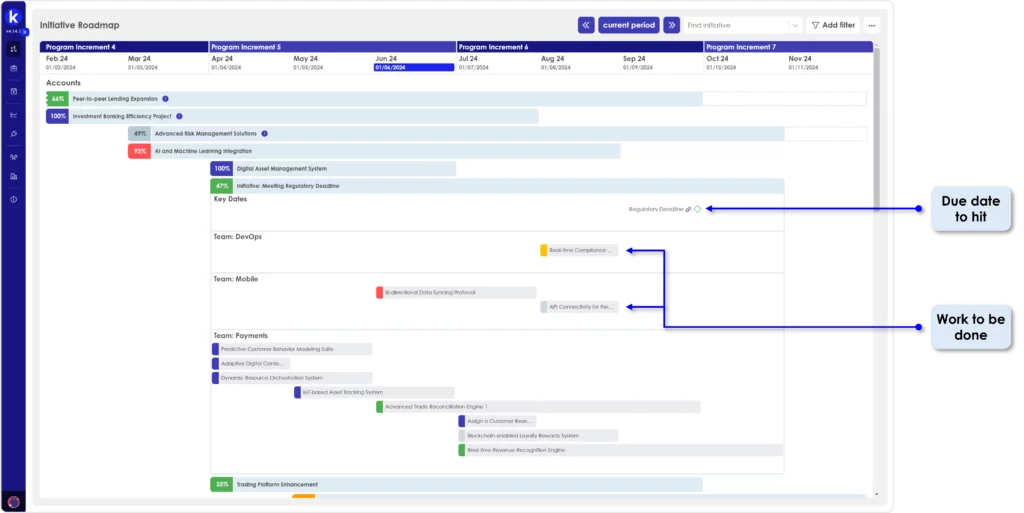Introduction
It remains frighteningly common to hear the expression “agility and due dates are not compatible”. While it might be possible to defend the idea of “no due dates” in the context of a startup or small team, it is not credible or realistic to hold this position in the context of an enterprise organization.
In this article, we’ll explore why due dates must form a critical part of the “move faster, create more value, for less” nirvana that your organization is striving for. We’ll also explain how the concept of a due date has evolved, how it differs from a traditional “milestone”.
What is a “due date”
A due date represents the planned date for achieving a specific objective. This is distinct from the actual work that needs to be completed.

For example, let us assume that the organization has a regulatory deadline to meet. In order to meet this deadline, we must deliver a collection of features. These features, along with their constituent tasks and stories are the work to be done. The due date, however, is the date by which these activities must be completed. The due date is dependent upon the activities that must be completed in order to achieve it. While we can prioritize the work to be done, regulatory deadlines remain fixed and cannot be prioritized.
📘 “I love deadlines. I love the whooshing noise they make as they go by.” ― Douglas Adams, The Salmon of Doubt: Hitchhiking the Galaxy One Last Time
How does a due date differ from a milestone?
Due dates and milestones are different concepts that should not be conflated. Milestones mark significant points or events in a traditional project, indicating the completion of major phases or deliverables and acting as internal checkpoints to gauge progress. They are often arbitrary and serve to measure whether the project is delivering at the speed that was initially intended.
In contrast, due dates are fixed points in time by which something must be achieved, often based on external commitments like regulatory deadlines, contractual obligations or dates agreed to facilitate management of inter-team dependencies. They exist independently of the initiative’s internal schedule and must be met regardless of progress on the underlying tasks. In an enterprise roadmap, milestones help manage the flow of work, while due dates provide a non-negotiable framework for completing critical deliverables, ensuring both internal progress and adherence to external commitments for effective prioritization and resource allocation.

Different types of due dates
There are essentially three different types of due dates that organizations commonly encounter:
External Due Dates
External due dates are imposed by entities outside the organization. These dates are non-negotiable and must be strictly adhered to. Common examples include regulatory deadlines, legal compliance dates, and mandatory upgrades due to end-of-life notifications for critical systems or software. These due dates are often beyond the control of the organization but are essential to meet to avoid legal repercussions and maintain operational integrity.
Aspirational Due Dates
Aspirational due dates are set internally by the organization. These dates typically originate from capacity-led planning sessions and reflect the organization’s internal goals and ambitions. While they may be flexible to some extent, they are crucial for driving progress and maintaining momentum within teams. Aspirational due dates help set a pace for development and encourage teams to push towards achieving strategic objectives within a reasonable timeframe.
Commercial Due Dates
Commercial due dates are those that have been agreed upon with customers or partner organizations. These dates often carry significant commercial implications, as missing them can result in financial penalties, damaged relationships, or lost business opportunities. Commercial due dates are critical in maintaining customer satisfaction and ensuring that the organization meets its contractual obligations.
Why are due dates important?
Drives Focus on MVP
Due dates compel teams to focus on delivering the Minimum Viable Product (MVP). Without the pressure of a due date, there is a tendency to over-engineer solutions or to include additional features that, while nice to have, are not essential to meeting the core objectives. The discipline of working towards a due date ensures that teams prioritize essential features and deliver value incrementally, aligning with agile principles of iterative development and continuous improvement.
Accountability
Due dates create a sense of accountability. Without them, there is a risk of fostering a culture of “mañana mañana” where deadlines are perpetually deferred. Most people are naturally inclined to work on tasks they find interesting or enjoyable, which may not always align with the organization's priorities. Due dates help mitigate the risk of drifting priorities, ensuring that critical tasks are completed on time and that the overall project roadmap remains on track.
Planning
In large organizations, planning and making commitments to various stakeholders—including the stock market, customers, regulators, and staff—are essential. Due dates are a crucial component of this planning process. They provide a framework within which organizations can allocate resources, manage risks, orchestrate dependencies and set realistic expectations for delivery. Without due dates, it becomes challenging to coordinate efforts across multiple teams, prioritize tasks effectively, and ensure that critical deadlines are met.
Management tool
Due dates also serve as a key element in identifying and addressing potential issues before they become critical. They help management teams understand where to focus their energy, what potential risks to be aware of, and where they may wish to intervene. By distinguishing between the “work to be done” and “dates to be hit” , organizations can ensure their teams are focused on the highest value work at any given point in time.
Conclusion
In summary, due dates an essential component of the enterprise agile environments. They ensure accountability, drive focus on the most critical deliverables, and facilitate effective planning and prioritization. By integrating due dates into your agile practices, your organization can achieve a balance between flexibility and structure, ultimately fostering a more productive and responsive work environment.

